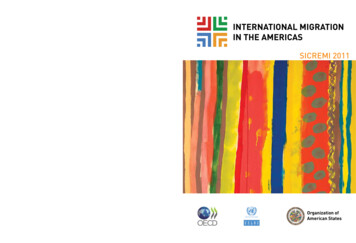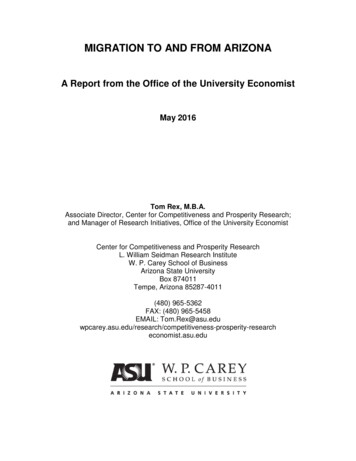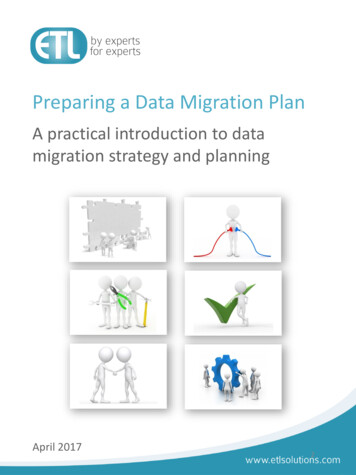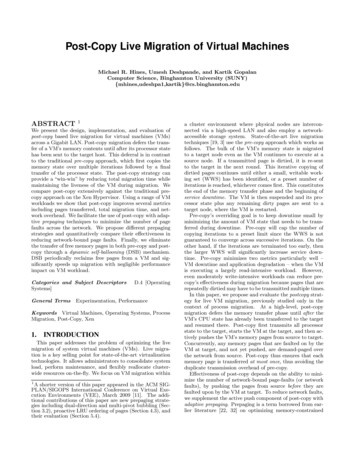
Transcription
OASThe methodology of this report is based on the Permanent Observation System on Migration (orSOPEMI) of the Organisation for Economic Co-operation and Development, adjusting to the needsof the region in accordance with a participatory process involving the countries of the Americasthrough a network of national correspondents and the participation of national and internationalorganisations working in the field of migration.The SICREMI is an initiative of the Migration and Development Program of the Department of SocialDevelopment and Employment of the Organisation of American States that aims to contribute to thepromotion and development of public policies that lead to improved migration management in theAmericas through the facilitation of dialogue, cooperation, institutional strengthening and accessto information.Organization ofAmerican StatesMigration and Development ProgramDepartment of Social Development and Employment17th Street and Constitution Ave., N.W.Washington, D.C., U.S.A. 20006www.oas.orgINTERNATIONAL MIGRATION IN THE AMERICAS SICREMI 2011This document is the first annual report of the Continuous Reporting System on International Migration in the Americas (SICREMI, for its acronym in Spanish). The report collects data from diversesources (censuses, surveys, administrative records, etc.) in order to process and disseminate information regarding the magnitude, trends, and characteristics of international migration in thecountries that participated in this first phase: Argentina, Belize, Canada, Chile, Colombia, Ecuador,El Salvador, Mexico and Uruguay.INTERNATIONAL MIGRATIONIN THE AMERICASSICREMI 2011Organization ofAmerican States
Organization ofAmerican StatesINTERNATIONAL MIGRATIONIN THE AMERICASFirst Report of the Continuous Reporting System onInternational Migration in the Americas (SICREMI)2011
OAS Cataloging-in-Publication DataInternational Migration in the Americas: First Report of the Continuous Reporting System on International Migrationin the Americas (SICREMI) 2011.p.; cm. Includes bibliographical references. (OEA Documentos Oficiales; OEA Ser.D)(OAS Official Records Series; OEA Ser.D)ISBN 978-0-8270-5652-71. Emigration and immigration--Economic aspects. 2. Emigration and immigration--Social aspects. 3. Emigrationand immigration law. 4. Alien labor. 5. Refugees. I. Organization of American States. Department of Social Development and Employment. Migration and Development Program (MIDE). II. Continuous Reporting System on International Migration in the Americas (SICREMI). III. Title: First Report of the Continuous Reporting System on InternationalMigration in the Americas (SICREMI) 2011. IV. Series.OEA/Ser.D/XXVI.2OGRANIZATION OF AMERICAN STATES17th Street and Constitution Ave., N.W.Washington, D.C. 20006, USAwww.oas.orgAll rights reserved.Secretary General, OASJosé Miguel InsulzaAssistant Secretary General, OASAlbert R. RamdinExecutive Secretary for Integral DevelopmentMauricio E. Cortes CostaDirector, Department of Social Development and EmploymentAna Evelyn Jacir de LovoCoordinator, Migration and Development ProgramAraceli AzuaraThe partial or complete reproduction of this document without previous authorisation could result in a violation of theapplicable law. The Department of Social Development and Employment supports the dissemination of this work andwill normally authorise permission for its reproduction. To request permission to photocopy or reprint any part of thispublication, please send a request to:Migration and Development ProgramDepartment of Social Development and EmploymentOrganization of American States1889 F ST N.W.Washington D.C. 20006, USAFax: 202-458-3149E-mail: migration@oas.orgThis publication was designed by Miki Fernandez of Ultradesigns, Inc., and was translated from the original Spanishby Mariana Parietti and Link Translations Inc. Karina Gould assisted with the review of the text and, together with AnaMaría Lara of the Migration and Development Program of the Organization of American States provided, logisticalsupport for the production of this publication.
/ iiiMarcia Bebianno Simões and Juan Manuel Jiménez Martínez, specialists of the Migration andDevelopment Program of the Department of Social Development and Employment (DSDE) ofthe Organisation of American States (OAS) were in charge of the technical coordination of thisReport. Georges Lemaitre, Principal Administrator of the Office of Employment, Labour, andSocial Issues, Non-Member State Economies and International Migration of the Organisationfor Economic Co-operation and Development (OCDE) provided advice and assistance at allphases of this publication.María G. Moreno Antelo of the Organisation of American States, Jorge Martínez Pizarro, Leandro Reboiras and Magdalena Soffia of the Latin American and Caribbean Demographic Centre(CELADE) of the Economic Commission for Latin America and the Caribbean (ECLAC), GeorgesLemaitre of the Organisation for Economic Co-operation and Development (OECD), and LuisHerrera Lasso of the Coppan Group also contributed to the elaboration of this report.A special thanks to Luis Herrera-Lasso, who’s pioneering ideas contributed to the early stagesof this project.The preparation and dissemination of this document was made possible through the generouscontributions made by the Ministry of Foreign Affairs and Cooperation of the Government ofSpain.
/ vFOREWORDInternational migration is one of the key topics on the policy agenda worldwide. Globalisation, income disparities between countries, demographic and economic imbalances – have allcontributed to the increased migration movements over the past twenty years, bringing peoplemany benefits, but also posing challenges to governments in many countries.One of the essential elements in furthering an understanding and managing of internationalmigration is reliable, cross-country, comparable data and a regular monitoring of movementsand policies.We are therefore especially pleased to present this first report on International Migration inthe Americas of the Continuous Reporting System on International Migration in the Americas(SICREMI, its acronym in Spanish). This initiative aims to contribute to the monitoring of international migration movements in the region through rigorous and up-to-date information onmigration flows. It also covers the principal policies and programs which the governments ofthe hemisphere direct towards an ever-growing migrant population, both in the countries of theAmericas themselves and in the countries of destination to their emigrants.This publication has been developed in collaboration with the Organisation for Economic Cooperation and Development (OECD). The SICREMI is modelled on the OECD’s ContinuousReporting System on Migration (SOPEMI, its acronym in French) established in 1973, whichprovides an information exchange mechanism to its Member countries through a network ofnational level correspondents which meets annually. The correspondents are appointed jointlyby the OECD and the governments of their countries and are supported by the key institutionsinvolved in the production of migration information in the countries. The information collectedis updated on an annual basis, where possible, and is based on data from administrative records in countries and from sample surveys and censuses. It has been systematised and harmonised, to the extent possible, according to criteria specified in the report.The publication will evolve over time, incorporating more and more countries in America andwill include in future years, an annual review of developments in migration policies. Its continuation requires the active support of the governments of the region.We hope that this first effort responds to the increasing demand for migration information andanalysis by the countries of the region.José Miguel InsulzaSecretary GeneralOrganisation of American StatesAngel GurríaSecretary-GeneralOrganisation for EconomicCo-operation and Development
vi / INTERNATIONAL MIGRATION IN THE AMERICAS SICREMI 2011 ISBN 978-0-8270-5649-7NETWORK OF NATIONALCORRESPONDENTSParticipating OAS Member States in the 2011 SICREMI ReportArgentinaMartín Arias Duval, Director, Dirección Nacional de MigracionesFederico Luis Agusti, Director, Dirección de Asuntos Internacionales y Sociales, Dirección Nacional deMigracionesBelizeMiriam Willoughby, Statistics Specialist, Acting Manager, Census Surveys and Administrative Statistics,Statistical Institute of BelizeCanadaMartha Justus, Director, Research and Evaluation, Citizenship and Immigration CanadaChona Iturralde, Acting Research Manager, Citizenship and Immigration CanadaChileFrancisco Pérez Walker, Director, Dirección de Asuntos Internacionales y Sociales, Dirección Nacional deMigracionesRaúl Sanhueza, Director, Dirección para la Comunidad de Chilenos en el Exterior, Ministerio de RelacionesExterioresPedro O. Hernández González, Section Chief, Departamento Planificación Migratoria Internacional, Dirección para la Comunidad de Chilenos en el Exterior, Ministerio de Relaciones ExterioresColombiaNestor Orduz, Advisor, “Colombia Nos Une” ProgramCesar Camilo Vallejo, Advisor, “Colombia Nos Une” ProgramFrancisco A. Melo, Advisor, “Colombia Nos Une” ProgramEcuadorFernando Solíz Carrión, Advisor, Secretaría Nacional del MigrantePatricia Ruiz, Planning Analyst, Secretaría Nacional del MigranteEl SalvadorJairo Damas Cruz, Chief of Migrant Workers Section, Ministerio de Trabajo y Previsión SocialMexicoErnesto Rodríguez Chávez, Director, Centro de Estudios Migratorios, Instituto Nacional de MigraciónUruguayCarlos Calvo, Director, División Estadísticas Sociodemográficas, Instituto Nacional de Estadísticas
/ viiEXECUTIVE SUMMARYMAJOR TRENDSThe Americas are a continent where, historically, migration patterns can be characterised bythree significant periods: a) until around 1950, the countries of the entire American continentwere destinations for transoceanic immigration from Europe in particular, only to become –with the notable exceptions of the United States and Canada –countries of emigration; b) starting around 1960 a permanent and increasingly intense emigration began from the countries ofLatin America and the Caribbean to developed countries, principally the United States, Canadaand Spain; and c) a moderate, but steadily increasing trend of intra-regional migration has developed over the past decades, which has seen Argentina, Costa Rica, Venezuela, and recentlyChile become regional migrant-receiving countries.North America is a region where immigration dominates; the United States and Canada receivehundreds of thousands of migrants each year. The United States, in absolute terms, has beenthe principal destination country of migrants at the global level with 36.7 million foreign-bornpersons (2009), representing 12% of the total population and with an immigrant entry flowgreater than one million per year (as measured by permanent residence permits issued). It isestimated that 20.5 million of the foreign-born population come from Latin America and theCaribbean and more than half of these were born in Mexico.Canada, for its part, has an immigrant entry flow of approximately a quarter of a million peopleper year (based on permanent residence permits issued) and is one of the OECD countrieswith the largest foreign-born population in relative terms (20% of its total population in 2006).With a population of almost 700 000 persons from Latin America and the Caribbean (11% of theimmigrant population), Canada is in third place after the United States and Spain as one of theprincipal destinations for Latin American and Caribbean emigration.In the case of Latin America and the Caribbean, out-migration has been, since the 1960s-andstill today- the principal direction of flows, although there has been a decrease in these movements due to the economic crisis of 2008.The tendency to emigrate persists and return movements to countries of origin have been limited, despite the difficult economic situation that exists in the United States and in Spain andthe diverse incentives and programs undertaken by origin country governments to foster thereturn of nationals living abroad.It has been essentially in Mexico and the rest of the Central American and Caribbean countriesthat emigration has been especially high in recent decades and for which proximity to the United States is in large part the explanation. Similarly, the fact that small and insular countries
viii / INTERNATIONAL MIGRATION IN THE AMERICAS SICREMI 2011 ISBN 978-0-8270-5649-7tend to have high rates of expatriation (OCDE 2004) is in part a consequence of generally morelimited educational and work opportunities. Comparatively, net migration rates for these regions reach very high levels, corresponding to the loss of approximately 8 to 12% of the population of a country over 20 years.Many countries of Latin America and the Caribbean have also lost important proportions oftheir youth population, with high percentages of net migration among this age group. Only in afew countries of the Americas does immigration actually contribute to the increase of the sizeof the working-age population, as is the case in Canada and the United States.IMMIGRATION IN 2008 AND 2009In absolute terms, in 2009, the United States and Canada together had an entry flow of approximately 3 184 600 permanent and temporary immigrants, of which 1 382 400 were permanent(43%).For the same year, an entry flow of 460 290 immigrants in total, was registered in the followingseven countries covered in this first report: Argentina, Chile, Colombia, Ecuador, El Salvador,Mexico and Uruguay. Argentina and Chile are the two principal destination countries for regional migrants.Immigration, in general terms, decreased in Canada and the United States by almost 6% from2008 to 2009, with this decrease occurring essentially among temporary migrants. A decreaseof 1% was also witnessed in the other seven Latin American countries analysed, especially inArgentina.However, the decrease in Argentina essentially reflects a drop in the number of persons regularised under a special programme. If regularised persons were excluded from the analysis,permanent immigration to Argentina would have actually increased by 85% from 2008 to 2009and temporary migration by 9%.As a percentage of the total population, immigration into Colombia, El Salvador, Mexico andUruguay in 2009 is particularly low, at less than one immigrant per thousand of the population. Argentina and Chile are the two countries with the most significant immigration of LatinAmerican countries with between 3 and 5 immigrants for every one thousand inhabitants, respectively. These levels remain low in comparison with those of Canada – with almost 20 immigrants (both permanent and temporary) per one thousand inhabitants- and the United States– 8 immigrants for every one thousand inhabitants. In general, the level of entry of flows intoCanada and the United States combined is, in proportional terms, almost seven times higherthan those of Argentina, Chile, Colombia, Ecuador, El Salvador, Mexico and Uruguay combined.On the other hand, permanent migration flows towards Argentina were proportionally of thesame magnitude as those towards France and Germany, and are three times greater than those to Japan; these three OECD countries were those with the lowest permanent migration percapita in 2009.In 2009, apart from Canada and the United States, immigration in the Americas continued to bea regional matter. Between 70 and 90% of immigration to Argentina, Chile, El Salvador, Ecuador, Mexico and Uruguay originated in the Americas, generally from neighbouring countries.
Executive Summary / ixConversely, for the United States and Canada, in comparative and relative terms, the countriesof the Americas were not as important as origin countries. They represented 40% of permanentmigration to the United States and 14% towards Canada.PERMANENT IMMIGRATION BY CATEGORY OF ENTRYPermanent legal labour migration is rather low in proportional terms in the United States, theprincipal destination country for Latin American migrants. The United States, however, has amuch more liberal family-oriented migration policy than other OECD countries, which facilitates, among others, the entry of adult siblings and of adult children of naturalised Americancitizens, subject to a numerical limit. Most countries provide for the admission of immediatefamily members (spouse and minor children), subject to certain conditions, but not of otherfamily members.The decline in labour migration in the United States as a result of the crisis occurred entirelyin temporary movements, which saw a 13 percent drop in 2008-2009 compared to the levelsof 2006-2007. Permanent labour migration was not affected, essentially because most of this(almost 90%) consisted of changes in status, that is, persons who were already employed in theUnited States as temporary workers and who were sponsored by their employers to obtain apermit for residency and work (Green Card).The migration of international students is much less developed in Latin America than it is inCanada (82 350 international students in 2008-2009) and the United States (348 000) where itconstitutes an entry channel for young persons who wish to stay on to work, and, on occasion,to settle after the completion of their studies.ASYLUM SEEKERS IN THE AMERICASAlthough Latin America and the Caribbean are not considered as important destination regionsfor persons seeking asylum from persecution, requests for asylum have increased to approximately 49 000 in 2009, an increase of 73% when compared to figures from 2008, and quadruplethe total recorded in 2000. By contrast, Canada alone received about 34 000 claims in 2009 andthe United States 38 000. Ecuador was the principal receiving country of requests for asylum inLatin America and the Caribbean, receiving almost 36 000 requests, in large part from Colombian citizens fleeing conflict zones near the border with Ecuador.UNAUTHORISED MIGRATIONFew countries have current statistics on the flows of unauthorised migrants. The United States produces periodic estimates which indicate that from an average of 850 000 unauthorisedmigrants entering annually between 2000 and 2005, the numbers have plummeted to approximately 300 000 per year between 2007 and 2009 (Passel and Cohn 2010). Furthermore, it isestimated that those from Mexico have dropped from 500 000 to 150 000 per year over thesame period. This decline is attributable in part to enforcement, but as well to the unfavourable employment climate in the United States, which has resulted in fewer potential migrantsattempting the trip north.
x / INTERNATIONAL MIGRATION IN THE AMERICAS SICREMI 2011 ISBN 978-0-8270-5649-7Although the most serious economic downturn since the Great Depression has reduced employer dependence on unauthorised immigrants to a certain extent, as evidenced by the highunemployment rates among Latin American migrants in the United States, it has not drivenmany of them back to their countries of origin.Unauthorised migration is not confined to the United States. It is a part of migration in everycountry and other countries in the Americas are subject to the phenomenon as well, but clearlynot on the same scale as the United States. Many countries in Latin America have carried outregularisations episodically, so that the unauthorised resident population has not accumulated. Argentina has carried out a significant regularisation programme since 2007, known as thePatria Grande Programme. Over the 2007-2009 period, close to 216 000 persons were regularised, amounting to some 10-15 percent of its total immigrant population. The most significantcountries of origin were the neighbouring countries of Paraguay, Bolivia and Peru. In Chile, the2007-2008 regularisation programme received 49 thousand applications, which representedapproximately 15% of the foreign-born population.EMIGRATION FROM THE AMERICAS TOWARDS OECD COUNTRIESEmigration remains the dominant theme in Latin America and the Caribbean with respect tomovements of populations throughout the region. From 2003 to 2009, almost 950 thousandpersons per year emigrated from the Americas towards OECD countries. Close to half of thesemovements were to the United States and about one quarter to Spain.It is striking to observe the extent to which legal migration levels from the Americas to OECDdestination countries have generally maintained themselves in the midst of the most severeeconomic crisis of the post-war years with the exception of migration levels to Spain and theUnited States.Economic downturns tend to affect labour migration the most, both because employers aremaking fewer requests to recruit from abroad as a result of lower levels of demand but alsobecause persons under free or facilitated movement regimes remain at home rather than riskan uncertain labour market abroad. Indeed, it is free-movement migration in the OECD zonewhich has been seen to be the most sensitive to the economic crisis and to have declined themost (OECD 2010a and 2011).RECENT DEVELOPMENTS IN REMITTANCE FLOWSAfter several decades of almost continuous growth, remittances flows to Latin American andCaribbean countries dropped by 12% between 2008 and 2009 and did not fully recover in 2010.Reductions in remittances observed in 2009 are due to several causes, such as a reductionin migration flows and stocks and a high concentration in the United States and in Spain, twocountries which were particularly hard hit by the 2008 financial crisis, as well as a strong presence of immigrants in the construction sector, one of the sectors most affected by the crisis.Remittances flows from the United States to Mexico and El Salvador, the two most importantLatin American communities in the United States, have been reduced by 18.6% and 4.2% respectively in 2009. Recent figures for Mexico indicate a reversal of the trend with a 6% increase
Executive Summary / xiin remittances flows in January 2011. Furthermore, remittances sent from Spain to Ecuadordecreased by 27%, from US 1.28 billion to US 944 million in 2010.THE LABOUR MARKET SITUATION OF EMIGRANTS FROM COUNTRIES IN THE AMERICAS IN RECENT YEARSOf the emigrant workers from the Americas in the United States and Europe, 45 percent arefrom Mexico; the Caribbean and the Andean Region each contribute close to 15 percent; withthe rest of Central America at 12 percent, the southern Cone of South America at 8 percent andCanada and the United States at 4 percent.The emigrant work force for all countries in the Americas except those of South America wasliving predominantly in the United States in 2008-2009. Between 80 and 90 percent of expatriateworkers from most Caribbean countries were concentrated there; the percentage was evenhigher for emigrants from Central America and reached fully 99 percent for Mexico.Emigrant workers from South American countries, on the other hand, were found more often inEurope, with about three quarters or more of those from Argentina, Bolivia, Ecuador, Paraguayand Uruguay living and working in Europe.Of the emigrant labour force born in Latin America and the Caribbean, men compose 60% ofthe total. This is due largely to the weight of Mexico. Mexican women make-up just 31% of thelabour force of Mexican origin and their participation rate is 45%. The result is an over-representation of men overall.In most Caribbean countries, women predominate in the emigrant work force, the exceptionsbeing Antigua and Barbuda, Cuba and Grenada. Conversely, men are in the majority in all Central American countries except Belize and Panama. The emigrant work force from South America tends to be more evenly balanced between men and women.For over half of the countries in the Americas, the number (and percentage) of expatriates witha tertiary qualification in the labour force of their countries of residence exceeds that of thosewith less than upper secondary education, for both men and women in 2008-2009. This is especially the case for women expatriate workers from the Caribbean, forty percent or more ofwhom have a tertiary qualification for most countries of this region. Only for expatriates fromPanama, Venezuela, Argentina, Chile, Canada and the United States among other countriesdoes one see emigrant workers with this high level of qualification.By contrast, relatively few expatriate workers from Mexico, El Salvador, Guatemala, Honduras,Bolivia and Ecuador have tertiary qualifications. These have constituted the bulk of migration forlesser skilled jobs in the United States for the first four countries and in Spain for the latter two.THE ROLE OF IMMIGRANTS IN EMPLOYMENT IN DESTINATIONCOUNTRIESThe immigrant labour force is generally more severely affected during recessions than thoseborn in the country for various reasons. Among others, they tend to be employed in sectors thatare more dependent on cyclical demand such as construction, hospitality and food services.
xii / INTERNATIONAL MIGRATION IN THE AMERICAS SICREMI 2011 ISBN 978-0-8270-5649-7Given that immigrants often constitute a more flexible population in the labour force, the employment of immigrants may be one of the ways in which labour markets adjust to reductionsin demand.In 2008 and 2009, the highest unemployment rates in the United States and in Europe were observed among workers from the Americas, followed by immigrants from other countries, andfinally by those born in the country.The unemployment rate of migrant workers from the Americas in the United States and Europeincreased from 5.3% in 2006 to 13.8% in 2009. Meanwhile, the rate for those born in the countryalso rose, but from 6.7% to 9.1%; the rate for immigrants from outside of the Americas increased by about 3.5 percentage points. From the perspective of the countries of origin, unemployment rates are especially unfavourable for immigrants from countries of the Americas,exceeding 10% among most of them for migrant men, and closing to 15% for migrant workersfrom Bolivia, Colombia and Ecuador.Unemployment rates have almost tripled for expatriate workers from the Andean Region (especially Ecuador) and from Mexico. Workers from the Caribbean and the Southern Cone haveseen smaller increases in relative terms.For female immigrants of the Americas, the unemployment picture was generally similar tothat of men.A phenomenon which is often observed under difficult economic conditions is the increase inthe rate of women who participate in the labour force. Women enter the work force in greaternumbers in an attempt to make up for the drop in family income after the male wage-earnerloses his job. Women often have better access to a part of the labour market that is not easily orwillingly sought by men, such as care for the sick or elderly or cleaning activities. The increasein women’s participation under these conditions is known as the “additional worker effect” andis one reason why the employment rate of women tends to maintain itself better than that ofmen during a downturn.Finally, the risk at this stage of the economic recovery is that unemployment in the destinationcountries remains persistently high. In the United States, the unemployment rate for emigrantsfrom the Americas for 2010 was at 12 percent, slightly higher than the 11.8 percent rate observed for 2009. The situation in Spain may not be very different. It would appear, therefore,that the sort of low-unemployment, plentiful-job situation which existed prior to 2008 is not yetaround the corner. It will take a strong recovery to reabsorb all of the current excess supplyin the labour force. The current demographic situation, with smaller youth cohorts and moreand more workers entering the ranks of the retired in most countries of Europe and the UnitedStates, may, however, help to provide a boost.
/ xiiiCONTENTSCHAPTER I RECENT TRENDS IN INTERNATIONAL MIGRATION .11.Recent trends in international migration .22.The labour market situation of emigrants from countries in the Americas in recent years .243.Principal migration indicators: macroeconomic, demographic, and labour market .384.Bibliography.485.Notes.49Notes and sources of country statistics tables .52CHAPTER II INTERNATIONAL MIGRATION IN THE AMERICAS .531.Introduction .542.Major trends .542.1 Estimates: growth and prominence.543.2.2 Geographic expansion and diversification of migration .57Migration within the Americas .583.1 Migration to the United States: primary destination .583.2 Migration to Canada: visible presence .
INTERNATIONAL MIGRATION IN THE AMERICAS This document is the first annual report of the Continuous Reporting System on International Mi-gration in the Americas (SICREMI, for its acronym in Spanish). The report collects data from diverse sources (censuses, surveys, administrative records, etc.) in order to process and disseminate in-










